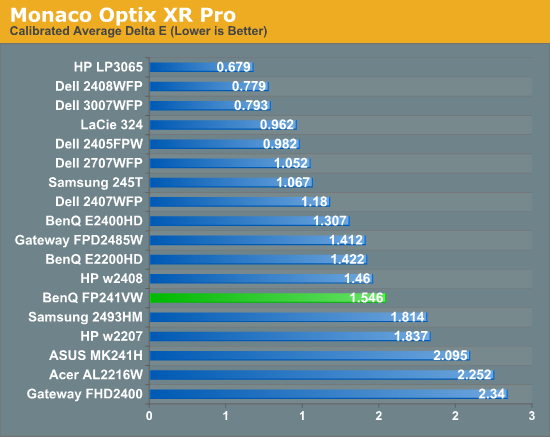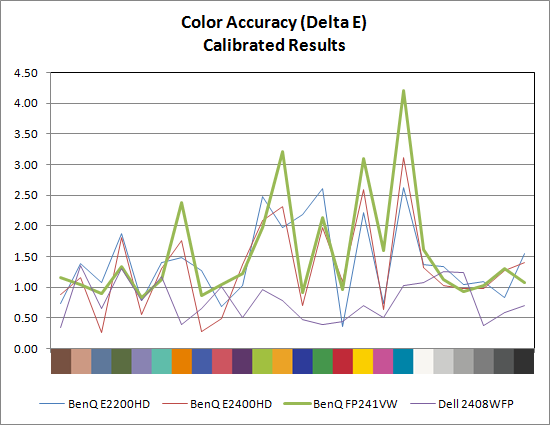Color Accuracy
Imaging professionals definitely like to have accurate colors, and the best way of assuring that your display shows the proper colors is to use a colorimeter and calibration software. However, not everyone has access to such tools and many users are unwilling to spend over $200, so we calibrate and test the various LCDs. We didn't perform a thorough evaluation of color accuracy on the FP241VW, so we will limit our Delta E comparison to calibrated performance where we target a white level of ~200 nits - anything more than that is too bright in our opinion. The FP241VW actually ended up at 270 nits, but that won't substantially affect any of the scores. Before we get to the results, here are the display settings we used on the BenQ LCDs. We let the LCDs stabilize for at least one hour before performing measurements. We will compare results with the Dell 2408WFP, which so far has achieved the best overall color accuracy of any LCD we have tested, as well as the previous two BenQ LCDs.
| LCD Brightness and Contrast Settings | ||
| Standard Calibrated (~200 nits) | Calibrated for Print (~100 nits) | |
| BenQ E2200HD | 65 Brightness, 50 Contrast "Normal" (95-95-95 RGB) |
20 Brightness, 50 Contrast "Normal" (95-95-95 RGB) |
| BenQ E2400HD | 73 Brightness, 50 Contrast "Normal" (94-94-91 RGB) |
30 Brightness, 50 Contrast "Normal" (94-94-91 RGB) |
| BenQ FP241VW | 35 Brightness, 50 Contrast (270 nits) "Normal/sRGB" (47-48-45 RGB) |
N/A |


After calibration, the FP241VW still fails to come anywhere close to the Dell 2408WFP - and in fact it doesn't even match the accuracy of the less expensive E2400HD. That said, it's interesting to note that the color accuracy curves for all three BenQ LCDs are extremely similar, to the point where I now have to wonder if backlighting has a far greater impact on color accuracy than I previously thought. It makes sense that better backlighting would allow the panels to achieve better color accuracy, but I don't have any evidence for this assertion other than the above chart. Anyone serious about color accuracy is probably going to want an average Delta E of around 1.0 or less post-calibration. So far, only S-PVA and S-IPS panels achieve that goal, although it's possible a better backlight would allow the A-MVA display to match the other displays. Note also how the bottom half of the above chart is dominated by LCDs that use TN panels.










114 Comments
View All Comments
james jwb - Thursday, June 18, 2009 - link
PS, also want to say that trying to get S-IPS/PVA in notebooks is also a great service to us out there who dream of this day, again, thanks for trying to highlight this issue :)JarredWalton - Thursday, June 18, 2009 - link
Dual-link DVI can do 120Hz at 1920x1200 - it's twice the bandwidth of single-link DVI. Most modern GPUs also support dual-link, but right now to my knowledge only 30" LCDs require it.james jwb - Friday, June 19, 2009 - link
ah that's good to know, and now you've said it, pretty obvious!stubey - Thursday, June 18, 2009 - link
I have the Benq FP241w, the older version of this model (without the lag-reduction technology). It is still widely available for around £350. Well worth it.It has 1:1 pixel-mapping, brilliant viewing angles, colour, adjustable / rotating stand etc.
Another example of older monitor better than the majority of newer more expensive ones.
The HP LP2475w is meant to be brilliant also - although probably more like £450......
marraco - Wednesday, June 17, 2009 - link
THANKS A LOTfor reviewing the real lag, instead of the "pixel response time".
Is the reason for I keep my CRT monitor instead of upgrading to a LCD. I really would like to update to a LCD, but never found a LCD without "phantoms". Vendors lie, lie, and lie about 5 ms response time, but when you see the images, they are really crappy.
This is somewhat hidden by the blur effect on some games, but I hate the blur effect, and ever disable it.
Most LCD monitors on exhibition shows only static or slow motion images, and I know why: they can't show fast framerates without ghosts.
I cannot buy a monitor until I see it working, but most retail vendors do not show the monitor working with fast moving images, so I absolutely crave for benchmark articles reviewing it.
I even written to nvidia.com forum asking for driver support. Drivers should include a calibration tool for remediation of this lagging ghosts. A possible enhancement would be to display the new framerate substracting a dimmed quantity of the former frame, so ghosts gets somewhat hidden, but got no answer from nvidia. Maybe they have really high quality monitors, and don't understand the need for it, so please, if you are reading this article, go to nvidia/ATI, forums/support, and ask for it.
Thanks a lot. I hope this kind of reviews generalize on internet, so LCD really improve.
marraco - Wednesday, June 17, 2009 - link
http://forums.nvidia.com/index.php?showtopic=99591">http://forums.nvidia.com/index.php?showtopic=99591marraco - Wednesday, June 17, 2009 - link
here is a link to the nvidia forum where you can ask for this driver feature:marraco - Thursday, June 18, 2009 - link
This is the link for ATI/AMD:http://forums.amd.com/forum/messageview.cfm?catid=...">http://forums.amd.com/forum/messageview...=347&...
marraco - Tuesday, June 23, 2009 - link
I got an answer from ATI:http://forums.amd.com/game/messageview.cfm?catid=2...">http://forums.amd.com/game/messageview....279&...
It looks like such feature is implemented at least for video.
Hrel - Wednesday, June 17, 2009 - link
My biggest concerns with monitors are Viewing angles first, then response times, (I don't care if it's processing or pixel lag or input lag I shouldn't EVER see ANY ghosting or be seeing 1 or 2 frames behind what my computer is processing and outputting), then contrast ratios and brightness and last is color accuracy. I'm completely satisfied with my current 20" Sceptre's color accuracy. It's a HELL of a lot better than my Dell Studio Laptop, that thing is so far off it's "almost" funny; but not really cause it's also kinda pissing me off. I AM NOT satisfied with the viewing angles, I use cardboard to prop up the back of it to angle down so the image isn't mucked up when I watch tv on it; it has tilt, it just doesn't tilt far enough.